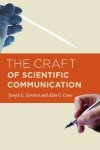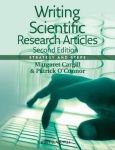Every expert needs to be able to communicate with impact, not only with other experts on their field, but also with policy-makers and common people. The following five books help you develop your communication, whether you are a novice researcher or an experienced writer.
 Harmon, J. E., & Gross, A. G. (2010). The craft of scientific communication. University of Chicago Press.
Harmon, J. E., & Gross, A. G. (2010). The craft of scientific communication. University of Chicago Press.
Harmon and Gross have done extensive research on scholarly articles and now provide practical advice on how to write effectively. The first hundred pages focus on the scientific article: how to introduces the problems, turn your evidence into arguments, and more. The second half of the book gives advice on how to communicate to the general public, and how to present the results in an engaging way.
 Russell, N. (2009). Communicating science: Professional, popular, literary. Cambridge University Press.
Russell, N. (2009). Communicating science: Professional, popular, literary. Cambridge University Press.
Russell’s book is a great choice for anyone interested in the big picture of science communication: the culture, sociology and mechanics of both professional and popular communication. Russell covers many interesting topics, such as ethics of science and scientific fraud, value of peer review and the quality of research. Some of the topics may feel a little outdated, but in general this is still worth the read.
 Johnsen, C. (Ed.). (2010). Taking science to the people: A communication primer for scientists and engineers. University of Nebraska Press.
Johnsen, C. (Ed.). (2010). Taking science to the people: A communication primer for scientists and engineers. University of Nebraska Press.
Today, it is important for experts to be able to communicate outside their field, directly to policy makers and the public in general. This collection of essays discusses better science communication and also offers practical advise on how to do it.
 Lebrun, J. (2011). Scientific writing 2.0 : A reader and writer’s guide : a reader’s and writer’s guide. World Scientific Publishing Company.
Lebrun, J. (2011). Scientific writing 2.0 : A reader and writer’s guide : a reader’s and writer’s guide. World Scientific Publishing Company.
This is a hands-on guide to writing scholarly articles to scientific journals. Lebrun takes a reader-first approach, giving advice on how to engage your reader and how to keep them motivated, and more. The second section of the book concentrates on the structure of the paper, with checklists of good and bad practices that can be used as a useful tool to avoid most common mistakes.
 Cargill, M. & O’Connor, P. Writing Scientific Research Articles: Strategy and Steps. Wiley-Blackwell.
Cargill, M. & O’Connor, P. Writing Scientific Research Articles: Strategy and Steps. Wiley-Blackwell.
This particular book is perhaps most useful for researchers at the beginning of their career. Research article structure is introduced, of course, and the whole process of writing is covered. What separates this book from others is the way the authors discuss the publication process: what happens, what the reviewers’ criteria for evaluating manuscripts are, how best to respond, and more. Everything is rounded up nicely with advice on how to develop these new writing skills even further.
For further reading tips on communication, see our favourites list.
Article image by congerdesign@Pixabay



